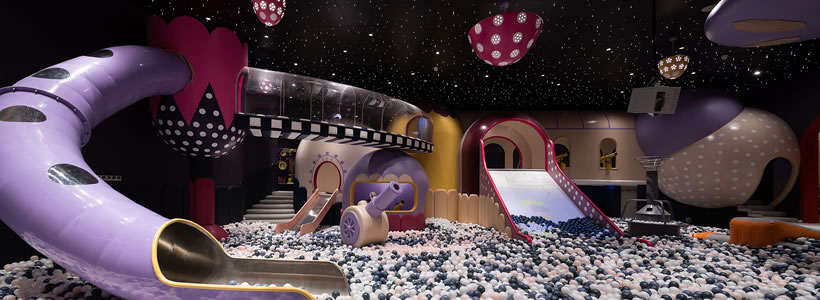
With the increasing demand for consumer experiences, the Children’s Park is no longer just a place to entertain, but also a place for parent-child interaction and immersive experiences.

Designers have abandoned the traditional design approach of relying on finished entertainment facilities, and rebuilt a perfect consumer experience which fully considers and meets the psychological needs of diverse target groups.
The MELAND Club has become not only a large parent-child indoor playground, but also a dreamland that breaks through the imagination boundary between adults and children and a memory album that preserves the good times of parents and children.

The mysterious and fantasy starry sky background and the whimsical welcome table, under the superimposed effect of the mirror ceiling, has created a surreal sense of breakthrough for the reception area, which implies that consumers are about to enter a dream city existing only in fairy tales.
Following the star tunnel to the shoe-changing area, the car-shaped shoe cabinets are interlaced and arranged in a row, which not only added a sense of dynamics to the space of the static life, but also quickly mobilized consumer curiosity and attracted their attention to the next space.

As the transportation hub of the whole project, MELAND City is both the diversion of the crowd and the intersection of the visitors flows. Entering the city, the houses simulating the architectural design of the Potala Palace have increased the streamlined feel of the entire space. The space adopts a rich and dramatic stage color, which outlines the mystery and grotesqueness of Grimm’s fairy tale.
The designer borrowed the concept of the NPC (non-player characters) in video games and created some cartoon doll installations in a unique way. They were placed at various nodes of the visitors flows, not only carrying the functions of indicating signs or trash cans, but also adding vividness to the story of the space. With the clock elements scattering in all corners and the huge building blocks descending from the sky, the flow of time and the traces of development are expressed in a concrete design approach, which intends to remind parents to cherish the time spent with children.

The ball pool is located in the southwest corner of the plane space, like an undeveloped jungle at the edge of the MELAND city. A large animal-shaped installation encloses the entertainment facilities while also cascades the climbs and slides. The lively mix of fantasy purple and exaggerated wave points stimulates children’s nature of having fun. Unlike traditional indoor climbing, the white background walls with red fulcrums as well as the red dots extending to the ground in the climbing area of MELAND Club have together created a stylish and grotesque artistic feel.
The design expression of the thematic narrative also extends to the restaurant area. The chimney-like columns are covered with transparent pale pink ‘bubbles’, and the irregular white dots on the ground symbolize the clouds. The simulated scene of the sky has interestingly ‘revealed the secrets of making dreams’ in the MELAND City. Inside the ‘bubble’ is the play area for the children, and the dining tables are distributed around the ‘bubbles’. It makes it easier for parents to look after the children while making reasonable use of the space.

The entire project has completed the excellent expression of the theme parent-child indoor playground, showing a high degree of completeness and consistency in the streamline and space narrative. The subtle line design connects different functional areas and realizes the rationality of the visitors flows. The narrative of the space, in turn, connects different spaces through a complete plot and leads the consumers to experience the wonderful journey of parent-child interaction. In a limited space, the designer’s childlike design approach to fulfill the consumer’s pursuit of the surreal experience will undoubtedly promote the market to optimize the interpretation of parent-child space.
Project name: MELAND Club
Location: Wuhan, China
Area: 3100 sqm
Design company: X+LIVING
Chief designer: Li Xiang
Project directors: Fanchen, Zhang Wenji
Customized furniture: LIXOXO
Photography: Shao Feng


